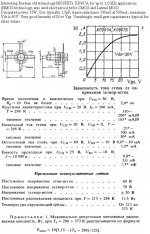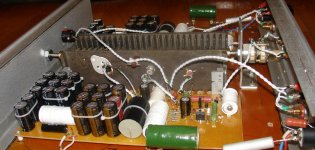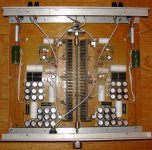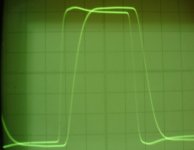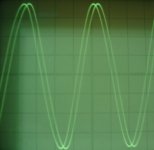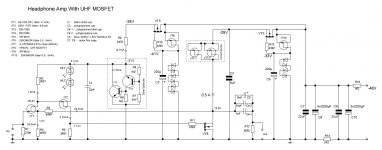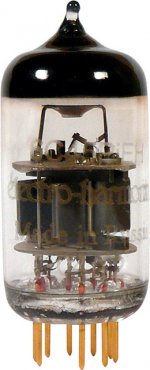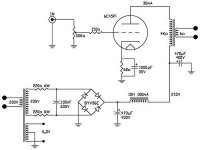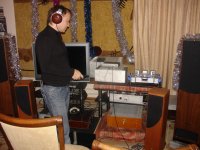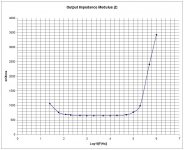I believe that the only way of getting close to tube’s sound with transistor designs is using of very low Ciss transistors. Although there is no theoretical or measurable support to this statement, listenings do prove it, and it makes a point to me.
With this idea, the KP907A lateral MOSFET (old Russian HMOS technology transistor, used up to 1,5GHz frequencies, that have specific linear Id vs Vgs) seduces me for already some time. I enclose some info from its datasheet. With max power dissipation 11W of this transistor, one can expect only around 1W output power with the Follower-like output stage, depending on the load value. It is too much for Pre and Headphone amps, and ridiculously small for a Power amp. But, finally I have convinced myself, that:
- even 1W could be enough for sensitive 97…105 dB speakers,
- there are current demanding 25…32 Ohms headphones,
- even preamps sometimes need to drive around 100 Ohms input impedance of power amps or other consumers,
- without paralleling of active small Ciss output transistors one might get the best sound,
- at this heat dissipation range, one can use a pair of RF power jFETs KP903A as a simplest current source, being a load for KP907A.
On this basis, I have put together the following prototype (the as-built schematics is enclosed), being equipped with all kinds of output connections (Eichmann RCA input connectors, Eichmann speaker posts, Neutrik silver headphone jack socket, RCA output connectors, DACT volume control). Soldering is done point-to-point, without PCB. I was afraid about possible ringing with UHF transistor, but everything is working without any additional adjustment. Enclosed are scope shots of 1 MHz sine and square wave signals reproduction, at 4V p-p level with 11 Ohms resistive load.
Even at 1V RMS output voltage it is possible to estimate sound quality with Castle Acoustics Pembroke speakers, and even with big PMC EB1i. The sound has lived up the expectations, it is extremely live-like. In spite that some average tinfoil caps and metallized polypropylene caps were used, the sound is excellent.
We also agreed with a friend of mine to arrange listening via his Denon AH-D7000 top level headphones. Presumably, the present schematics can get some justification from the low (25 Ohms) impedance of these headphones.
Enclosed are also shots of the prototype in its actual state, some case work is pending still.
With this idea, the KP907A lateral MOSFET (old Russian HMOS technology transistor, used up to 1,5GHz frequencies, that have specific linear Id vs Vgs) seduces me for already some time. I enclose some info from its datasheet. With max power dissipation 11W of this transistor, one can expect only around 1W output power with the Follower-like output stage, depending on the load value. It is too much for Pre and Headphone amps, and ridiculously small for a Power amp. But, finally I have convinced myself, that:
- even 1W could be enough for sensitive 97…105 dB speakers,
- there are current demanding 25…32 Ohms headphones,
- even preamps sometimes need to drive around 100 Ohms input impedance of power amps or other consumers,
- without paralleling of active small Ciss output transistors one might get the best sound,
- at this heat dissipation range, one can use a pair of RF power jFETs KP903A as a simplest current source, being a load for KP907A.
On this basis, I have put together the following prototype (the as-built schematics is enclosed), being equipped with all kinds of output connections (Eichmann RCA input connectors, Eichmann speaker posts, Neutrik silver headphone jack socket, RCA output connectors, DACT volume control). Soldering is done point-to-point, without PCB. I was afraid about possible ringing with UHF transistor, but everything is working without any additional adjustment. Enclosed are scope shots of 1 MHz sine and square wave signals reproduction, at 4V p-p level with 11 Ohms resistive load.
Even at 1V RMS output voltage it is possible to estimate sound quality with Castle Acoustics Pembroke speakers, and even with big PMC EB1i. The sound has lived up the expectations, it is extremely live-like. In spite that some average tinfoil caps and metallized polypropylene caps were used, the sound is excellent.
We also agreed with a friend of mine to arrange listening via his Denon AH-D7000 top level headphones. Presumably, the present schematics can get some justification from the low (25 Ohms) impedance of these headphones.
Enclosed are also shots of the prototype in its actual state, some case work is pending still.
Attachments
Very nice VladimiK!
1 watt can be enough in certain situations. I have been living with 2 watts OTL amp for many years. However, I only use it for mids and tweets. Not for bass, that's where there is never enough power. I use active crossover.
At normal listening levels we rarely need more than 100 to 500 milliwatts with reasonably sensitive speakers.
1 watt can be enough in certain situations. I have been living with 2 watts OTL amp for many years. However, I only use it for mids and tweets. Not for bass, that's where there is never enough power. I use active crossover.
At normal listening levels we rarely need more than 100 to 500 milliwatts with reasonably sensitive speakers.
Nice work, Vladimir!
I hadn't seen any of these HMOS devices before. Very linear but very low gm, probably not too important as a source follower.
Interesting that you use 2SJ103 on the front end, and even more that source feedback on the input side carries a high 23.5mA, which dwarfs the current through the device.
Thank you for publishing your excellent design,
Hugh
I hadn't seen any of these HMOS devices before. Very linear but very low gm, probably not too important as a source follower.
Interesting that you use 2SJ103 on the front end, and even more that source feedback on the input side carries a high 23.5mA, which dwarfs the current through the device.
Thank you for publishing your excellent design,
Hugh
Member
Joined 2009
Paid Member
I believe that the only way of getting close to tube’s sound with transistor designs is using of very low Ciss transistors.
I agree too that much of the magic is that 1W. But your special FETs are unobtainable outside of USSR (unless you gonna send me some
Why settle for 'getting close to tube' when you can get your 1W from a tube ?
Single Ended Class-A Power Amplifier using 6C45Pi - Electronics Now! schematics, Electronic circuit, PCB or project for Electronic.
Attachments
Last edited:
I agree too that much of the magic is that 1W. But your special FETs are unobtainable outside of USSR (unless you gonna send me some)
Why settle for 'getting close to tube' when you can get your 1W from a tube ?
Single Ended Class-A Power Amplifier using 6C45Pi - Electronics Now! schematics, Electronic circuit, PCB or project for Electronic.
Hello, Bigun
Sending of the FETs is possible, but would be nice to proceed via group buy, since getting them and sending them take much time, and shipment costs are to be remembered.
As for using tubes themselves, this would cause some additional complications and drawbacks, and I find that proper choice of UHF transistors allows to really overtake tube designs soundwise and conveniencewise. In particular, I doubt that the choke power supply in tube schematics overtakes the follower-like approach at the output stage of my schematics. All tube designs that I listened up to now, they are already behind soundwise.
Last edited:
Nice work, Vladimir!
I hadn't seen any of these HMOS devices before. Very linear but very low gm, probably not too important as a source follower.
Interesting that you use 2SJ103 on the front end, and even more that source feedback on the input side carries a high 23.5mA, which dwarfs the current through the device.
Thank you for publishing your excellent design,
Hugh
Hello, Hugh
The low Gm does matter, therefore I use current NFB, even with the follower-like output stage. With NFB, output impedance value goes below 1 Ohm. There are around 10 various types of these russian HMOS lateral FETs (KP901, 902, 904 (75W 100V 300pF 0,3S), 905, 907, 909, 911, 913 (100W 100V 200pF 1S) ... ), some of them are up to 70...100W heat dissipation. All of them have relatively low Gm, and in order to get to optimal working point, one must spend 5...7V of positive gate bias. This is not convenient for low-wattage schematics. All of them could be substituted by modern NXP parts, but Id vs Vgs curves are different for NXP.
As for power jFETs types, there is only one RF part - KP903.
Last edited:
Member
Joined 2009
Paid Member
Hello, Bigun
Sending of the FETs is possible, but would be nice to proceed via group buy, since getting them and sending them take much time, and shipment costs are to be remembered.
As for using tubes themselves, this would cause some additional complications and drawbacks, and I find that proper choice of UHF transistors allows to really overtake tube designs soundwise and conveniencewise. In particular, I doubt that the choke power supply in tube schematics overtakes the follower-like approach at the output stage of my schematics. All tube designs that I listened up to now, they are already behind soundwise.
I have some good chance to get directly from former USSR so if it's some hassle then I am OK to wait. You see, I have 3 chasis in my basement, they may be last SS projects I do for sometime. One of these chasis is set up for a Class A power follower (it will be tube driven so gate threshold voltage is not going to be a limitation) and it is waiting for me to choose that 'special' single FET as the output device (two total for stereo). It will be cascoded so that it doesn't need to dissipate a lot of power. Plus, it doesn't have to be a KP903, but you have got me all excited about it and it would be pitty to use something else
One of these chasis is set up for a Class A power follower (it will be tube driven so gate threshold voltage is not going to be a limitation) and it is waiting for me to choose that 'special' single FET as the output device (two total for stereo). It will be cascoded so that it doesn't need to dissipate a lot of power. Plus, it doesn't have to be a KP903, but you have got me all excited about it and it would be pitty to use something else
What idle current do you plan to use? With a single KP903A it could be 0,3...0,4A only.
With KP907A 1...2A. With KP913A 2...4A.
KP904A also could be used at 2...3A, but it is not UHF, it is VHF part with around 350pF Ciss. The KP904A I could get locally for around 7...8USD per pcs. All the parts have all pins isolated from the mounting stud.
Member
Joined 2009
Paid Member
Actually, the tube schematic, cannot provide the low output impedance necessary (damping factor) to control the low-impedance headphones.Why settle for 'getting close to tube' when you can get your 1W from a tube ?
I'll likely have only +/-10V swing at most and worse case into 4R load that's 2.5A peak. If I don't see myself running this at more than 2.5A idle so that is worse case.
You mentioned that there are NXP equivalent parts ?
I would suggest to try Mitsubisi RD15HVF1 RF MOSFET, for these operation conditions.
However, even its Ciss = 57pF is much higher than that for tubes, while KP907A has Ciss below 10pF.
Member
Joined 2009
Paid Member
I think 57pF is good enough for me ... these devices are all over ebay - but from China - what's the chances of them not being fakes ?
I have got 4 pcs of these Mitsubisi parts from local seller, which gets parts directly from Singapore and Malaysia, however, have not tested them still. Since these parts have higher Gm, they can act as followers without NFB. However, soundwise, I find that with moderate current NFB like in this thread's schematics, and linear UHF output parts, final sound is even better than that of No NFB headphone amp http://www.diyaudio.com/forums/solid-state/185386-no-nfb-headphone-pre-amp.html#post2509272
We had a listening session with my friend, who is a fan of headphones. He came to me with Denon AH-D7000 headphones and Perreaux SXH2 headphone amplifier. My Sennheiser HD-595 headphones also were listened, but they are far from being competitors to the Denon. We listened several test audiophile CDs. First we were impessed how good soundstage, including deep bass, comes from this amp via PMC EB1i, below 1W power. Actually, 0,5W listening is quite comfortable level even with 89dB EB1i.
Although an owner usually tends to underestimates equipment of other persons, in this case he had nothing to object against this thread's amp. It is better than Perreaux SXH2 in all aspects - more articulated bass, especially from acoustics instruments; individual instruments are better resolved; microdetails and "air" are better. Unfortunately, we have no other headphone amps better than Perreaux SXH2 for further comparison.
Just subjective impressions, not pretending for being a truth.
Although an owner usually tends to underestimates equipment of other persons, in this case he had nothing to object against this thread's amp. It is better than Perreaux SXH2 in all aspects - more articulated bass, especially from acoustics instruments; individual instruments are better resolved; microdetails and "air" are better. Unfortunately, we have no other headphone amps better than Perreaux SXH2 for further comparison.
Just subjective impressions, not pretending for being a truth.
Attachments
Last edited:
not true, the circuit Bigun reffers to is designed for 6 ohmsActually, the tube schematic, cannot provide the low output impedance necessary (damping factor) to control the low-impedance headphones.
you can use any trafo on the output and drive any impedance easily
its a matter of personal taste
I recommend you visit CanJam at RMAF and listen for yourself
I was there but did not spend much time with headphones
here some link just for fun
CanJam at RMAF - Show Stopper: The Amazing Audez'e LCD-3 | InnerFidelity
http://www.eddiecurrent.com/ZDT.html
I recommend you visit CanJam at RMAF and listen for yourself
I was there but did not spend much time with headphones
here some link just for fun
CanJam at RMAF - Show Stopper: The Amazing Audez'e LCD-3 | InnerFidelity
http://www.eddiecurrent.com/ZDT.html
Last edited:
I have measured frequency dependence of the output impedance of this thread's schematics. It is near 0,6 Ohms at medium frequencies. Subjectively, I would say that one of the previous more powerful No NFB schematics with 0,25 Ohms output impedance does not able to provide similar bass articulation like this schematics. There is something definitely more important in amp-speaker interaction that simply Zout parameter, it is puzzling to me. In last two designs I used current NFB connected to the source of input jFET, and in both cases the bass is amazing.
Attachments
its a matter of personal taste
here some link just for fun
CanJam at RMAF - Show Stopper: The Amazing Audez'e LCD-3 | InnerFidelity
2A3
Thanks a lot, Adason, I do like this Eddie Current 2A3's concept. It is a real gear for trying to compete with it. One thing has attracted my attention, that most economic Solen polyprop caps were used in the design (seen it at pictures).
So is the life, among hundreds of tin-foil, copper-foil, silver-foil caps, we usually choose Solen metallized caps. Anyway, I beleve that 2A3 is really a masterpiece for its price. Interesting to hear listening impressions from some owners of 2A3.
Last edited:
- Status
- This old topic is closed. If you want to reopen this topic, contact a moderator using the "Report Post" button.
- Home
- Amplifiers
- Solid State
- 1W SE Class A – Powerful Headphone or Weak Power Amp
